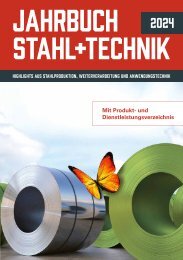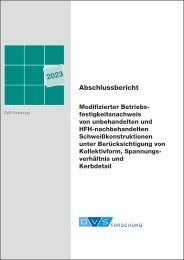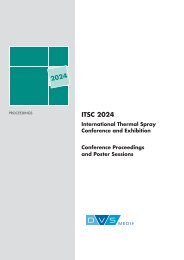STEEL + TECHNOLOGY 04/2019 EXTRACT
STEEL + TECHNOLOGY 04/2019 EXTRACT
STEEL + TECHNOLOGY 04/2019 EXTRACT
You also want an ePaper? Increase the reach of your titles
YUMPU automatically turns print PDFs into web optimized ePapers that Google loves.
<strong>STEEL</strong> <strong>TECHNOLOGY</strong> | 55<br />
high productivity leading to low cost production.<br />
• simple and reliable equipment,<br />
• focus on consistency of efficiency,<br />
• the “human factor”,<br />
• continuous improvement and investment<br />
in people,<br />
• environmentally friendly production,<br />
• optimum logistics and material flow,<br />
• clear and integrated investment program.<br />
Beside continuous investment in people<br />
and major investment steps in new technology,<br />
it is crucial for any steel plant to<br />
continuously find ways to increase efficiency,<br />
reliability and maintainability of<br />
existing technology and keeping an eye on<br />
the safety improvement overall. For decades,<br />
BSE and BSW have been following<br />
this strategy, having developed various<br />
innovative solutions all around the electric<br />
arc furnace in combination with the safety<br />
philosophy of the Badische group itself.<br />
Very often melt shops intend these<br />
days to install dedicated additional safety<br />
equipment or systems with the target to<br />
improve working safety with big emphasize<br />
of state-of-the-art “machine safety”<br />
in the execution of these additional systems,<br />
but disregard the status of the main<br />
process equipment and the related process<br />
safety.<br />
The electric arc furnace (EAF) as a main<br />
process unit for melting of “un-virgin”<br />
material, like scrap or DRI, is a very good<br />
example for the fact, that the condition and<br />
set-up of the main equipment according to<br />
production environment and pre-conditions<br />
is essential for the process safety and reliability.<br />
By ensuring a high level of process<br />
safety and reliability of the EAF, automatically<br />
a relative high level of working safety<br />
is reached, because one of the main hazards<br />
of the EAF is its product, liquid steel,<br />
in undefined conditions.<br />
By applying this fact, the following 3<br />
levels for overall safety of an EAF can by<br />
defined:<br />
• right set-up and condition of the EAF<br />
main equipment and sections,<br />
• set-up of operational standards and procedures,<br />
• installation and use of dedicated additional<br />
safety equipment.<br />
Steady and consequent realization of the<br />
first 2 levels leads additionally to higher<br />
process efficiency and optimized consumption<br />
figures because delay rates will<br />
be minimized.<br />
Figure 2. Thermo-scan of BSW-EAF #2 after tapping (Picture: BSE)<br />
Set-up of main process equipment<br />
(safety degree 1)<br />
By analyzing the set-up of an EAF as main<br />
plant for melting of “un-virgin” metallic raw<br />
material, first of all state-of-the-art technical<br />
and safety principles and rules according to<br />
the applied physical and technical principles<br />
need to be implemented. Briefly, the following<br />
physical and technical principles and<br />
requirements need to be fulfilled:<br />
• efficient electric power input through<br />
the arc,<br />
• efficient chemical power input by the<br />
oxygen technology system,<br />
• set-up of EAF shell according to tap<br />
weight and hot heel, as well as shell<br />
volume for charging,<br />
• set-up of EAF movements for charging,<br />
de-slagging, tapping, etc.<br />
• implementation of the EAF in the melt<br />
shop layout by respecting aspects like<br />
internal material flow, connection to<br />
power and utilities supply, connection<br />
to de-dusting system, etc.<br />
During a modernization project 2 forty<br />
years old EAFs were substituted by one<br />
state-of-the-art 145-t EAF to fulfil production<br />
requirements of the mini mill. The<br />
modernized EAF has been installed at the<br />
place of one of the outdated EAFs in the<br />
melt shop. The existing internal buildings,<br />
such as transformer house, control and<br />
hydraulic rooms were re-used. The old<br />
foundations were substituted by completely<br />
new foundations.<br />
One of the main important topics of the<br />
modernization was to guarantee a consecutive<br />
2-bucket-charge with 0.6 t/m³ scrap<br />
density. This requirement led to a shell setup<br />
with an inner diameter of 7,800 mm of<br />
the lower shell and 7,500 mm of the watercooled<br />
panels. The overall height of the<br />
upper shell resulted in 3,400 mm. This<br />
shell layout resulted in an overall required<br />
electrode stroke of 6,000 mm.<br />
Now the question was how to set up<br />
the EAF according to the production target<br />
within the existing melting bay and to comply<br />
with state-of-the-art safety principles<br />
and rules. The following explanation will<br />
highlight briefly the engineering solutions<br />
regarding the aspects of reliability and<br />
safety for operation and maintenance within<br />
the life-cycle of the EAF.<br />
As a first example the required electrode<br />
stroke of 6,000 mm shall be mentioned.<br />
That big electrode stroke was realized by<br />
really rigid and stable design of the electrode<br />
lifting system. A main aspect of this<br />
is a stiff design of the gantry, as well as<br />
electrode lifting columns and electrode<br />
arms combined with self-centering column<br />
guiding units, also designed for good maintainability.<br />
Another important safety aspect of the<br />
EAF is the implementation of fail-safe-principle<br />
in case of complete power failure.<br />
The hydraulic system design features, that<br />
the EAF can be carried into safe condition<br />
even by a complete power failure. Safe<br />
condition of the EAF means:<br />
• EAF in horizontal position,<br />
• all 3 electrodes in upper position,<br />
• roof in upper position and swivelled out.<br />
Furthermore, the height of the upper shell<br />
of 3,400 mm shall by analyzed regarding<br />
safety aspects of the design. The design<br />
of the water-cooled sidewall panels can by<br />
summarized as following:<br />
• overall height 3,400 mm,<br />
• 3 individual cooling circuits,<br />
<strong>STEEL</strong> + <strong>TECHNOLOGY</strong> 1 (<strong>2019</strong>) No. 4


















